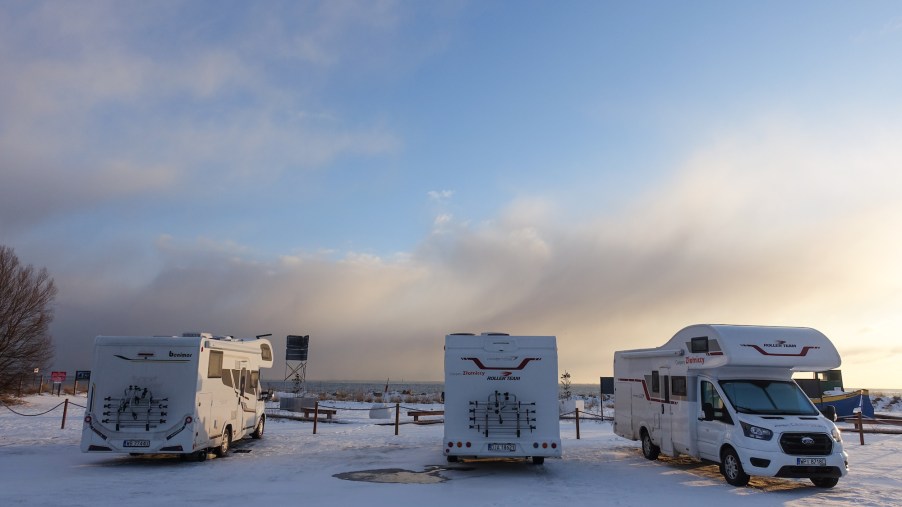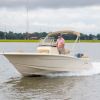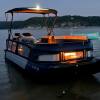
Which RV Is the Easiest to Drive?
Ever driven an RV? If you’re planning a multi-day road trip, a camper might be the perfect vehicle for you. Perhaps you’ve considered buying one, but the price was a bit out of range. Or you’ve never had time to take vacations. Or maybe the prospect of driving one seemed daunting. If the last reason is holding you back, you’re not alone. Some RVs can be huge, and maneuvering them can take time and practice.
But if you can afford a camper and have some vacation time, don’t let the fear of piloting one hold you back. In fact, some RVs are quite easy to drive. Below are the three RV classes, in order from hardest to easiest to maneuver.
The Class A RV
First, it’s essential to know what types of RVs are on the market. They’re categorized into three classes. The first — Class A — consists of the largest motorhomes. According to Consumer Reports, Class A vehicles can be as long as 45 feet, though most measure between 30 and 36 feet. Given their length, they can house plenty of amenities. It’s common to see a Class A RV outfitted with a bedroom, living room, kitchen, and even a full bath. Class As boast ample storage space and come in various finishes and floor plans. For all of these features, Class A motorhomes start around $90,000 and can exceed half a million dollars.
It’s also essential to understand how Class As are manufactured. Many use a V10 or V8 gas or diesel engine and sit atop a large commercial chassis. Bus-like drivetrains and other components are assembled, with the living quarters built around them. Finding replacement parts for these components can prove challenging, making repairs expensive.
Neither the gas- nor diesel-powered versions are especially fuel-efficient compared to other similar-sized vehicles. However, the diesel version will get you more mpg than the gas version and enjoy a longer working life.
Importantly, Class As aren’t subject to the same number of safety regulations as other RVs. Moreover, Class As typically aren’t designed to handle significant impacts.
Because you’re essentially driving a large bus, you’ll need some practice if most of your driving experience has been in a sedan or compact SUV. Expensive repairs and safety concerns also make Class A RVs less than an easy ride.
The Class C RV
Class C RVs are the most affordable. They’re distinguished by a sleeping area housed in an area overhanging the cab. A length that ranges from 22 to 35 feet provides plenty of space for living amenities and additional sleeping space. Between four and eight people can typically sleep in a Class C RV and enjoy ample living space, a full bathroom, convertible dinette, and more. You’ll pay between $70,000 and $200,000, but you’ll find a Class C well worth the cost.
Class C vehicles employ a cutaway chassis that holds the box-like cabin. Some Class Cs are known as Super Cs because they’re built on medium-duty truck platforms. They’re great if you want greater durability and heavier towing capacity. After all, you might want to two your car around with you for quick jaunts into town. Like Class As, Class Cs can be difficult to maneuver and find parking for, though Class Cs are considerably easier to drive than Class As.
Still, Class C RVs can be tricky to the inexperienced, especially the larger ones. Maneuvering a 30-foot vehicle takes time to master. Be aware that passengers should ride in the cab when the vehicle is moving. The living quarters are not designed for safety in the event of a crash and might fall apart if struck by another vehicle. Those in the cab will enjoy better protection.
The Class B RV
Class B RVs are by far the easiest to drive because they’re modified commercial vans. So if you’ve driven a van or even a large SUV before, you’re in luck. Their relatively small stature makes them easy to maneuver and park and improves fuel efficiency over Class As and Cs. Class B vehicles are also the safest, with stability control and front airbags. Plus, they’re the easiest to service, so you won’t spend as much money on repairs as you would other models.
Many Class B RVs, such as the Winnebago Revel, come with features like adaptive cruise control that can simplify your driving experience. Using a Mercedes-Benz Sprinter chassis, the Revel also has traction control and electronic stability to help keep everyone safe as you head out to explore. The Coach House Arriva, another Mercedes-based RV, includes many Mercedes-Benz driver assist systems and built-in navigation. And with 3.0-liter V6 turbodiesel engines powering both, you’ll get plenty of miles out of the Arriva and Revel.
The Roadtrek Zion comes with similar features, along with wind and sway assistance features, hill-start assistance, drift compensation, and more. This Promaster chassis-based RV packs a 3.6-liter V6 that’ll help get you and your passengers to your destination smoothly and safely. This RV is truly easy to drive. And many others on the market are waiting for you to unlock their doors.


